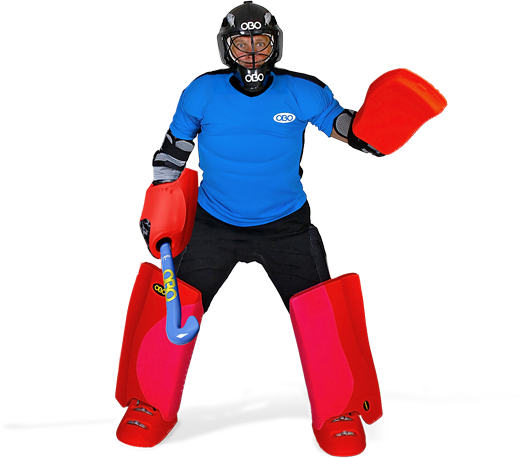KEEPERS RESOURCES

Standing when the ball is outside your half
Being aware of the need to be aggressive and acting correspondingly, will further your ability to control the play; able to shut down attacking chances by acting with confidence and awareness of the game’s development.
Standing on your line
Rather than coming off their line to prepare for any offensive breakaways into the D, you will often see a lot of goalkeepers staying back on the line, even when the ball is in the opposition’s zone. Passive goalkeepers who are not as comfortable aggressively stepping out to cut off a breakaway by actively running out to tackle, will often stay close to their line, even when the play is outside their half; ‘rooted’ to their goal line. By being so deep, they can play a shot, if a breakaway occurs; covering all options in order to block the incoming shot, rather than challenging out; allowing them to play to their strengths in angle play and reflexes, for a reactive save according to the incoming shot.
Staying nearer to the goal line means that the goalkeeper is further way from the play, often unable to react in time to a breakout play from the opposition, through their own defence (facing 2 on 1s, 3 on 2s etc.). As a result of being so deep within the D, you will have to be a lot quicker ‘off the mark’ in reacting to a lone player breaking into the zone, if you intend to tackle them successfully; immediately sprinting straight out, off your line to the top of the D, when you need to confront an open player running into the D, in order to make the interception.
Standing at the top of the D
At higher levels of the game, where the action is more fast paced and open, you will often see goalkeepers standing far off their line; readily anticipating an attack when the ball is in the opposition’s half and 25. Standing at the top of the D, you are nearer to the action. With a better view of the action, by gaining a closer view (rather than staring at a distance), you can also get a clearer look at things that are happening and are therefore able to make more accurate calls to your team; relating the dangers of free and mobile opposition players. Other than showing outward confidence to the team and opposition alike, as well as getting a better view of the pitch, from where they can shout commands to their team mates, it allows you to be ‘quick off the blocks’ in responding to defensive breakdowns and resulting scoring opportunities as they occur.
By confidently stepping so far out, you are closer to the action; able to quickly intercept a free attacker or pass into the D, without having to move into position to do so (by running in etc.). Ready and anticipating, instead of being ‘on the back foot’ and ‘slow footed’, you can see the danger developing from the outset, and respond immediately to it: showing good anticipation skills and a positive thinking aggressive mindset. This way, you increase your chances of disrupting passing plays simply by being in the right place and the right time.
Against a breakaway, an inactive goalkeeper in this situation would normally stand near, or even on the goal line, making it much more difficult to make the interception, as they have to race out in full kit to make the tackle. Being off your guard and not watching the play will leave you an easy target against skilled shooters. However, by being ready for an incoming player you stand a greater chance of successfully making the tackle.
Being aggressive
Standing at the top of the D means you are able to shut down plays more easily by being effectively “already there”; not having to sprint out off your line to meet an attacker or loose ball, but simply being on ‘the doorstep’ to the action. By being closer incoming play, you have less to travel to meet the attackers; setting up in an advanced position, ready to deal with overhead aerial passes into the D, leaving you up against an open breakaway situation, or multiple player scenario (with further attackers running in as the ball is held). An aggressive attitude in being ready and alert makes sure you are ready for the challenge; able to spring immediately into action as the player breaks through your defence and in onto goal.
As a result of being decisive and aggressive in your play, there are a number of possible actions that you can take against opposition plays breaking through the ’25. Disrupting such attacking plays allows your defence to get back in time to help out, as well as shutting down the present scoring chance, to deny the opportunity of a goal against.
Such scenarios include:
-
Making attacking clearances by clearing loose balls into the D (like aerials or strong hits in), which incoming runners are attempting to latch onto for a tip-in or breakaway chance
-
Making interceptions at the top of the D; running out on the angle of the attacker’s run, to slide tackle, to relieve the attacker of the ball and eliminate a scoring chance
-
Challenge the attacker coming into the D: meeting them early to challenge (staying on your feet and looking big, forcing them to go round you), and forcing them wide, so that you can force the shot wide, or move back with them to block a shot on goal they attempt
Being agile
Being aggressive in coming out to the top of the D to challenge coincides with agility and being mobile around the D; in order to get back in time to meet a shot if a pass is made around or into the D for a play on through to goal, you need to be quick enough and athletic enough to get back to cover the open ground. Working on overall fitness (to build up the required ) and practising roaming around the D at training, via respective drills, will help you learn when and how to come out to challenge, whilst being comfortable doing it.
Where should I stand?
Ultimately it is up to you to decide where to stand, according to your individual style of game; if you prefer to hang back and play the angles to limit a shooting chance, then you are more likely to play deep within your D and not step out to the top ready to challenge incoming plays. However, to take full control of your D, you need to be aggressive in stepping forward; ready for any attack and following the game play, influencing it as best as possible in ‘dominating the D’. By challenging with your positioning, you are able to control the play and shut down scoring chances; denying the opposition goal opportunities by acting like a spare defender.
If you are happy to act aggressively, and confident in your tackling abilities and aggressive style of play (being decisive, so as not to back away from a challenge and give the attacker the upper hand), then you should definitely be active in standing further up in the D when the ball is under control. Having a strong defence to rely on is helpful and important, but communication and awareness of where they are is crucial to success.
Comments
Leave Your Comments Below
















































